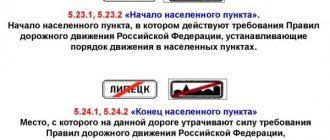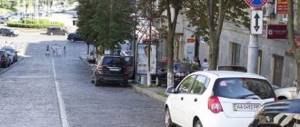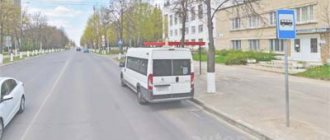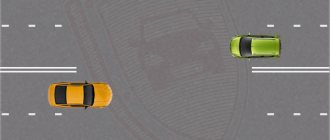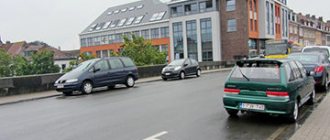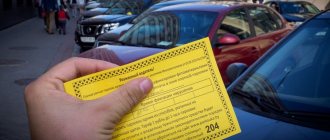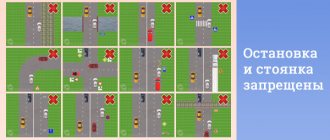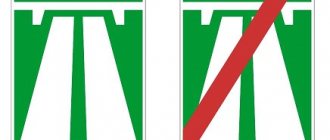- July 22, 2018
- Automobile law
- Oksana Sergeeva
As everyone knows, any vehicle cannot be constantly in motion. Sooner or later, the driver has to make stops, for example to load or unload the passengers he is transporting. Or, if the trip is long in nature, for example, moving from one region to another, it is clear that you cannot do without parking, since both the driver and the vehicle necessarily need temporary rest.
It is in such situations that questions may most often arise regarding what a stop is and what a parking is, where they can be made and what the traffic rules say about this. In order to avoid possible problems and unforeseen situations, it is necessary to unconditionally know what the traffic rules say about stopping and parking, how these concepts differ from each other, and also where such actions can be performed and where it is strictly prohibited.
Basic concepts of stopping and parking
Stopping and the action called “parking” are similar in that in both cases the movement of traffic stops. The differences lie in the duration of both, and the purpose of performing the maneuvers.
Concepts in traffic rules, differences in designations
The traffic rules explain both terms as follows:
Stop” is a deliberate stop in the movement of a vehicle for up to 5 minutes, as well as for longer if this is necessary for boarding or disembarking passengers or loading or unloading the vehicle.
Parking" is the deliberate stopping of the movement of a vehicle for a period of more than 5 minutes for reasons not related to the embarkation or disembarkation of passengers or the loading or unloading of the vehicle.
There is another significant difference between them. According to traffic regulations, parking is not permitted where stopping is prohibited. But sometimes you can stop for a short time on sections of the road where parking of technical equipment is prohibited.
How many minutes can you stand
The traffic rules describe exactly how many minutes you are allowed to stop driving in each case:
- If the car does this for up to 5 minutes, the driver has completed the stop. He can wait for passengers to disembark or for cargo to be picked up. Or neither one nor the other happens during this time. But if the car was at rest for up to 5 minutes and then moved, it would simply stop rather than park.
- When the vehicle remains in place for more than this time, the action is considered parking. People can get out of it, take out or load things. But if more than 5 minutes have passed, the car has parked.
Sometimes a vehicle stops moving for more than 5 minutes, and this does not mean that it has parked. There is such a term as a forced stop. It can be caused by extraordinary circumstances that make it impossible to travel.
The difference between a stop and a parking lot
Looking at these two actions, and speaking very simply, the main difference can be noted - duration. But, first of all, it must be a deliberate end to the movement of the vehicle. That is, if a tree unexpectedly fell on the roadway in front of you, and you had to resort to sudden braking, then this action does not apply to the concepts of “stopping” and “parking.” Traffic regulations define this maneuver as a forced completion of the movement. And stopping and parking are premeditated actions that you, let’s say, thought about in advance.
As already mentioned, these two concepts differ in time. If you stop driving for less than five minutes, then this is definitely a stop. Therefore, it does not matter at all what the passengers do, and, most importantly, the driver of the vehicle. The absence of movement of the vehicle for a period of more than five minutes, during which things are loaded or, conversely, removed from the vehicle, is a stop. The same goes for boarding (disembarking) passengers.
Parking is the absence of movement of the vehicle for a period of more than five minutes. It can also be associated with loading things and boarding (disembarking) passengers. For example, you got out of the car to smoke. It took you 4 minutes and fifty-nine seconds. This action is called stopping. You got out of the car, lit a cigarette and at the same time unloaded the car. All this took about five minutes. This action is also called stopping. The third option is to stop moving in order to talk with a friend. The duration of the conversation and, accordingly, the stopping of the vehicle was five minutes and one second. Therefore, based on the time it took for this action, we can safely say that you had a parking lot.
Road signs "Stop" and "Parking"
Road signs “Stop” and “Parking” also have noticeable differences:
- The first exists only for public transport and is numbered 5.16. It can be supplemented by markup 1.17. Here, ordinary vehicles are prohibited from certain actions: turning around, reversing, parking.
It is undesirable for non-route vehicles to stop even for a short time in the zone of influence of the symbol. This is acceptable when you need to let people out, and the vehicle itself will not interfere with a bus or trolleybus. Here, too, all cars give way to public transport that resumes traffic.
More on AutoLex.Net:
Is it allowed to cross a solid road when going around an obstacle?
- The symbol indicating the parking area is number 6.4 and can be supplemented by signs 8.6.1-8.6.9, which require vehicles to be placed in a certain way. There are parking lots that are public or designated for any category of cars. In the second case, it is also supplemented by the designations 8.4.1-8.4.8, allowing them to be in this zone. The numbers next to 6.4 show that you have to pay to place a car on the territory.
Signs and road markings
The driver must be attentive and focused while driving at all times. After all, he is obliged to see all the elements of traffic organization on the roadway.
Road marking lines on the roadway are of no small importance. The effect of the “Stopping and parking prohibited” sign is limited to them in the same way as to designated intersections. On the road, these markings are painted in yellow.
A solid line prohibits stopping. However, only when it is installed next to a road sign. Otherwise, it is used to mark the edge of the roadway.
A broken yellow line along the curb prohibits parking. It must also be placed next to the relevant road sign installed.
Regarding the stop on the left side, it is worth noting that it is not prohibited if there are tram tracks on one of the edges of the roadway. However, in practice, for the most part, such a road has continuous road markings, which do not allow the above-described actions.
Stopping and parking in populated areas
Stopping and parking of vehicles in populated areas is permissible not only where there are permitting symbols. But there are clear rules here.
Is it possible to stop on the side of the road?
In a city or village, you can stop a car on the side of the road if it is located on the right side of the road. Parking is also permitted here. Paragraph 12.1 of the traffic rules states that vehicles are allowed to be parked parallel to the direction of travel. But prohibitory signs should not be located nearby, and there cannot be any infrastructure features that prevent stopping:
- tram rails;
- railway crossing;
- bridges, overpasses, tunnels;
- sections where the distance between solid markings, the edge of the road and the vehicle will be less than 3 m;
- pedestrian crossing;
- dangerous turn, rise, area with poor visibility;
- lanes for cyclists;
- a traffic light, if it is not visible from behind the vehicle;
- minibus or taxi stops;
- intersection.
You can stop or park on the left side of the road, if we are talking about a passenger car or a cargo vehicle weighing up to 3.5 tons. But only when the path has 1 lane in each direction, or it is generally one-way.
Where is it allowed to stop outside a populated area for a truck?
According to clauses 12.3, 12.4 and 12.5 of the traffic rules, you can stop driving outside the city on the side of the road on the right side if there are no areas and features listed in subsection 12.4 of the “Rules...” nearby.
Long-term parking outside the city for a truck or any other vehicle is permitted only in places equipped for it or where there is no roadway. If you need to park for a short time, this is done everywhere except:
- areas where stopping is prohibited (from clause 12.4);
- on the main road if there is a 2.1 symbol;
- within a radius of 50 m from the railway crossing.
Is it permissible to stop under a bridge?
You can stop under the bridge only if:
- this territory is not under the influence of prohibitory signs;
- there are no features listed in clause 12.4 of the traffic rules.
The building itself is not a place to stop, much less to park vehicles. But the area under it can be absolutely safe, and does not apply to the bridge.
Watch this video about the rules of stopping and parking in populated areas:
Places where stopping is prohibited
Stopping is prohibited in the following places:
- in the coverage area of sign 3.27 and where yellow markings 1.4 are applied along the edge of the roadway;
- along the entire length of the 5.1 motorway and the “road for cars” 5.3. The shoulder on such roads is intended only for a forced stop, and parking is allowed in special areas equipped outside the road and marked with signs 6.4 or 7.11;
- on tram tracks, as well as in the immediate vicinity of them, if this creates interference with the movement of trams;
- at railway crossings 1.1 The crossing area is considered to be the distance between barriers or signs 1.3.1 (1.3.2);
- in tunnels 1.31 and under any bridges, overpasses, overpasses;
- on overpasses, bridges, overpasses, if there are one or two lanes for traffic in a given direction. If there are three or more passing lanes, both stopping and parking are permitted;
- in places where a parked vehicle will force other road users to detour across a continuous marking line or along a dividing strip. The width of the free section of the roadway must be at least 3 m;
- at pedestrian crossings and closer than 5 m in front of them (from the side of approaching vehicles);
- in places with limited visibility (less than 100m in at least one direction) on the roadway. At the same time, stopping and parking on the side of the road is not prohibited;
- at intersections of roadways and closer than 5 meters in any direction from them. The exception is parking at a T-junction with a continuous marking line at a distance of at least 3 m from it, or with a continuous median strip. With this configuration of the intersection, only straight movement is possible at it, so driving around a parked vehicle is carried out in the same way as on any other section of the road outside the intersection;
- closer than 15 meters in both directions from the stop of route vehicles or the parking of passenger taxis. There is also an exception here - a short stop is allowed only for boarding and disembarking passengers, if this does not create interference with route vehicles and taxis;
- in places where a stopped vehicle will block traffic lights or road signs for other drivers;
- in places where a stopped vehicle will make it impossible to enter and exit or interfere with the movement of pedestrians.
Area of operation of the “No Stopping” and “No Parking” signs
Symbols 3.27 and 3.28 do not allow you to stop moving. Validity area of "No Stopping" and "No Parking" signs:
- located only on the side of the track where the sign is attached;
- may be regulated by the designation 8.2.2 indicating the length of the territory in meters;
- ends at the nearest road intersection in the direction of travel or at the entrance to or exit from a populated area, if there are no other restrictions before that;
- terminated by symbol 3.31.
Signs and plaques
Stopping and parking is prohibited, it may be done in another way. Namely, information signs. Stop and parking signs installed together with them either reduce or increase the coverage area.
A sign with two vertical arrows with a number between them indicates the length of the area where stopping and parking is prohibited. Or one of them. It all depends on what sign the sign is under.
An additional information sign with a number on it indicates that after this distance a zone prohibiting stopping or parking will begin.
Validity area of the “Public Transport Stop” sign
The coverage area of the “Public Transport Stop” road sign is around it or in front of it, since it is placed in the middle or end of this territory. The symbol can be supplemented by the indicator 8.2.1, which reflects its length. Beyond this distance the bus stop ends.
The extent of the zone can also be indicated by marking 1.17. And if the stop is large, symbol 5.16 is duplicated. But the fact that it is always two-way does not indicate its influence on the opposite side of the roadway. There may not be a stop there if the same symbol is missing.
More on AutoLex.Net:
The last group of symbols from Appendix 1 of the Traffic Regulations are additional information signs: characteristics, features
Comparative characteristics
When we are talking about a deliberate cessation of traffic for a short period of time, while passengers are being transported or cargo is being handled, we can talk about such a maneuver as stopping.
Parking is a cessation of traffic that is not associated with passenger transportation or cargo, which takes more than 5 minutes. For example, if a car stops near a clinic to drop off a person, this is a stop. When a vehicle is parked for an hour or more, it is already a parking lot.
It is interesting that even the longest process is called a stop, the main thing is that it is associated with passengers or unloading or loading of goods.
A stop is also a short-term cessation of movement for less than five minutes, it does not even matter the type of activity of the driver or his passengers.
There are certain rules regarding stopping and parking a vehicle:
- On the right side of the road you can park your car on the side of the road. It is important that if the side of the road is occupied by some objects or other cars, you should not park your car on the roadway;
- it happens that there is no shoulder, then the car is allowed to be parked along the edge of the roadway;
- the last option allowed was the sidewalk.
It is usually customary to stop on the right side of the road, but exceptions have been made, so stopping on the left side is also allowed.
It is important that such delays are strictly permitted in cities, towns, and villages. This is possible when the road is two-lane and there are no tram lines in the center. You can stop on the left side of the road when there is one-way traffic. In such a situation, the presence of tram tracks does not matter.
Interestingly, parking and deliberate interruption of traffic for the purpose of disembarking passengers are not allowed for freight transport. Only stopping to load or unload goods is permitted.
Restricted parking zone
An area with a restriction of any duration of parking is indicated by symbol 3.28, but not only. Prohibited actions:
- wherever stopping is not allowed;
- outside the city in the space of influence of sign 2.1;
- at the railway crossing and at a distance of 50 m from it.
In addition, there are also signs that do not allow parking on certain days: 3.29 for odd days, 3.30 for even days. They have the same features as 3.28, but only at the specified times.
There are restrictions for curbside parking. In principle, this is allowed, as the 2nd paragraph of clause 12.2 of the traffic rules says:
Parking on the edge of the sidewalk bordering the roadway is permitted only for cars, motorcycles, mopeds and bicycles in places marked with sign 6.4 with one of the signs 8.4.7, 8.6.2, 8.6.3, 8.6.6 - 8.6.9.
All other types of transport cannot be parked on the sidewalk. But this territory, as an exception, can sometimes be used as a unloading zone. This is allowed by clause 9.9 of the traffic rules:
The movement of vehicles of road maintenance and utility services is allowed, as well as access along the shortest route for vehicles delivering cargo to trade and other enterprises and facilities located directly next to the roadsides, sidewalks or pedestrian paths, in the absence of other access options. At the same time, traffic safety must be ensured.
The main thing is that there are no limiting characters there.
The Rules use the following basic concepts and terms
The Rules use the following basic concepts and terms:
“Highway” - a road marked with sign 5.1 ** and having carriageways for each direction of travel, separated from each other by a dividing strip (and in its absence, by a road fence), without intersections at the same level with other roads, railway or tram tracks, pedestrian or bicycle paths.
“Road train” is a mechanical vehicle coupled to a trailer(s).
“Bicycle” is a vehicle, other than a wheelchair, which has at least two wheels and is generally propelled by the muscular energy of the occupants of the vehicle, in particular by means of pedals or handles, and may also have an electric motor of rated maximum power in continuous load mode not exceeding 0.25 kW, automatically switching off at speeds over 25 km/h.
“Cyclist” is a person driving a bicycle.
“Bicycle path” is a road element (or a separate road) structurally separated from the roadway and sidewalk, intended for the movement of cyclists and marked with sign 4.4.1.
“Driver” is a person driving a vehicle, a driver leading pack animals, riding animals or a herd along the road. A driving instructor is treated like a driver.
“Forced stop” is the cessation of movement of a vehicle due to its technical malfunction or danger created by the cargo being transported, the condition of the driver (passenger) or the appearance of an obstacle on the road.
“Main road” - a road marked with signs 2.1, 2.3.1-2.3.7 or 5.1, in relation to the one being crossed (adjacent), or a road with a hard surface (asphalt and cement concrete, stone materials, etc.) in relation to the dirt road , or any road in relation to exits from adjacent territories. The presence of a paved section on a minor road immediately before the intersection does not make it equal in importance to the one it intersects.
“Daytime running lights” are external lighting devices designed to improve the visibility of a moving vehicle from the front during daylight hours.
“Road” is a strip of land or a surface of an artificial structure equipped or adapted and used for the movement of vehicles. The road includes one or more carriageways, as well as tram tracks, sidewalks, shoulders and dividing strips, if any.
“Road traffic” is a set of social relations that arise in the process of moving people and goods with or without vehicles within the boundaries of roads.
“Road accident” is an event that occurred during the movement of a vehicle on the road and with its participation, in which people were killed or injured, vehicles, structures, cargo were damaged, or other material damage was caused.
“Railway crossing” is the intersection of a road and railway tracks at the same level.
“Route vehicle” is a public vehicle (bus, trolleybus, tram) intended for transporting people on roads and moving along a set route with designated stopping places.
“Motor driven vehicle” is a vehicle, other than a moped, driven by an engine. The term also applies to any tractors and self-propelled machines.
“Moped” is a two- or three-wheeled mechanical vehicle, the maximum design speed of which does not exceed 50 km/h, having an internal combustion engine with a displacement not exceeding 50 cubic meters. cm, or an electric motor with a rated maximum power in continuous load mode of more than 0.25 kW and less than 4 kW. Quadricycles with similar technical characteristics are considered equal to mopeds.
“Motorcycle” is a two-wheeled motor vehicle with or without a side trailer, the engine displacement of which (in the case of an internal combustion engine) exceeds 50 cc. cm or the maximum design speed (with any engine) exceeds 50 km/h. Motorcycles are considered tricycles, as well as quadricycles with a motorcycle seat or motorcycle-type handlebars, having an unloaded weight not exceeding 400 kg (550 kg for vehicles intended for the transport of goods), excluding the weight of batteries (in the case of electric vehicles), and the maximum effective engine power not exceeding 15 kW.
“Settled area” is a built-up area, the entrances to and exits from which are indicated by signs 5.23.1, 5.23.2, 5.24.1, 5.24.2, 5.25, 5.26
“Insufficient visibility” - visibility of the road is less than 300 m in conditions of fog, rain, snowfall, etc., as well as at dusk.
“Overtaking” is the advance of one or more vehicles associated with entering a lane (side of the roadway) intended for oncoming traffic and subsequent return to the previously occupied lane (side of the roadway).
“Shoulder” is an element of the road adjacent directly to the roadway at the same level with it, differing in the type of surface or highlighted using markings 1.2.1 or 1.2.2, used for driving, stopping and parking in accordance with the Rules.
“Limited visibility” is the driver’s visibility of the road in the direction of travel, limited by the terrain, geometric parameters of the road, vegetation, buildings, structures or other objects, including vehicles.
“Traffic hazard” is a situation that has arisen during traffic in which continued movement in the same direction and at the same speed creates a threat of a traffic accident.
“Dangerous cargo” - substances, products made from them, waste from industrial and other economic activities, which, due to their inherent properties, can pose a threat to human life and health during transportation, harm the environment, damage or destroy material assets.
“Advanced” is the movement of a vehicle at a speed greater than the speed of a passing vehicle.
“Organized transportation of a group of children” - organized transportation of eight or more children on a bus that is not a route vehicle.
“Organized foot column” is a group of people, designated in accordance with paragraph 4.2 of the Rules, moving together along the road in the same direction.
“Organized transport convoy” is a group of three or more motorized vehicles following directly one after another along the same lane with constantly turned on headlights, accompanied by a lead vehicle with special color schemes applied to the outer surfaces and blue and blue flashing lights turned on. red flowers.
“Stop” is a deliberate cessation of the movement of a vehicle for up to 5 minutes, as well as for longer if this is necessary to board or disembark passengers, or to load or unload a vehicle.
“Safety island” is an element of the road arrangement that separates traffic lanes in opposite directions (including lanes for cyclists), structurally separated by a curb stone above the roadway or designated by technical means of traffic management and intended to stop pedestrians when crossing the roadway. The traffic island may include part of the dividing strip through which a pedestrian crossing is laid.
“Passenger” is a person, other than the driver, who is in (on) a vehicle, as well as a person who enters (gets on) the vehicle or exits (gets off) the vehicle.
“Parking (parking space)” is a specially designated and, if necessary, arranged and equipped place, which is also part of a highway and (or) adjacent to the roadway and (or) sidewalk, shoulder, overpass or bridge, or is part of an underpass or underbridges spaces, areas or other objects of the road network, buildings, structures or structures and intended for organized parking of vehicles on a paid basis or without charging a fee by decision of the owner or other owner of the highway, the owner of the land plot or the owner of the corresponding part of the building, structure or structures.
“No Parking” sign and its coverage area
The “No Parking” sign has a coverage area in accordance with one of the conditions:
- to the intersection of roads located along the route of cars;
- up to symbols 5.23.1, 5.23.2, 5.25, meaning the beginning of a city or village;
- up to one of the designations 5.24.1, 5.24.2, 5.26, installed at the exit from the populated area;
- until 3.31, signaling that any restrictions have ended;
- until symbol 6.4, meaning that parking starts from here.
In previous cases, it can be installed without an arrow. If 3.28 is supplemented with other symbols, they mean:
- 8.2.2 – length of the segment over which its influence extends;
- 8.2.3 with a down arrow demonstrates that parking is not permitted in front of or after the sign, at a short distance;
- 8.2.4 is attached next to the designation 3.28 in a large area where parking is not allowed;
- 8.2.5 and 8.2.6 show that parking cars is prohibited along houses or on the street.
Where is parking allowed if there is a prohibition sign?
Territory of operation 3.27. may also be limited to yellow markings 1.4., applied along the roadway at its edge. In this case, 3.27. will not apply to the nearest intersection or the end of the city, but to the place where this marking ends.
Same thing with 3.28. – immediately after its installation, a yellow broken line 1.10 can be applied. As soon as this marking is completed, that’s it – parking will be possible.
To better understand where you can stop or stand, consider some questions from the theory exam papers:
- Question No. 1. Can a driver stop at the request of a traffic controller in the coverage area of 3.27? (see picture).
Photo: can the driver stop at the request of a traffic controller in the coverage area 3.27
The correct answer is yes, he can. Justification is in clause 6.15. The traffic rules state that drivers are required to follow the orders of the traffic controller even if they contradict the requirements of road signs. - Question No. 2. Is it possible for the driver to stop after the sign to pick up a passenger?
Photo: is it possible for the driver to stop after the sign for the purpose of boarding a passenger
? The correct answer is no, it is not allowed, since in conjunction with 3.27. An additional sign 8.2.4 has been used, indicating that it is forbidden to stop either before or after the sign. - Question No. 3. Is it possible for the driver of a route vehicle to stop where a citizen “votes”?
Photo: Is it possible for the driver of a route vehicle to stop where a citizen “votes”
? The answer is no, it’s impossible, since the requirements are 3.27. do not apply to minibuses, but only in places indicated by 5.16. – 5.18.
"No Stopping" sign and its coverage area
The influence of the “No Stopping” sign extends only to the side of the road where it is fixed. The coverage area may be limited:
- same as territory of influence 3.28;
- the end of a segment where stopping is not allowed by the rules, that is, leaving the bridge, after 5 m from the zebra crossing, etc.;
- completion of markup 1.4;
- additional signs on which the extent of the influence of the symbol is written in meters.
Next to 3.28 there may be a sign 8.24 “A tow truck is working.” It means that vehicles left here will be transported to the penalty area. After all, parking where you can’t even stop is even more prohibited. But if the driver stopped driving the car for less than 5 minutes and did not leave the car, the vehicle will not be taken away. The motorist will simply be fined.
Difference between parking and stopping a car
“What is the difference between parking and stopping?” — drivers are interested.
The difference between parking and stopping lies in two significant points:
- During the maneuver:
- if you are going to stop the car for a short time up to 5 minutes, then it is a stop;
- any actions exceeding 5 minutes will be considered parking.
- The purpose of the maneuver:
- if the purpose of stopping your vehicle is unloading and loading any things, items, objects and (or) getting passengers into or out of the car, then this is a stop;
- if your actions after stopping the car engine differ from loading and unloading, disembarking and landing, then this is parking (parking).
"Regulated parking zone" sign
The “Regulated parking zone” sign 5.29 shows that parking is possible on the territory, but only as prescribed by additional symbols or markings:
- plate 8.6.1 requires parking the car in the direction of travel;
- 8.6.2 allows you to park it along the road with the right front and rear wheels on the pavement;
- 8.6.3 allows parking on the sidewalk, placing the vehicle parallel to the direction of travel;
- 8.6.4 requires that cars be parked at an angle of 90 degrees to the side of the road;
- 8.6.5 requires a location similar to the previous one, but the rear of the vehicle must be facing the roadway;
- 8.6.6 allows you to drive your rear wheels onto the sidewalk, and 8.6.7 allows you to drive your front wheels;
- 8.6.8 will allow vehicles to be parked on the sidewalk, positioned perpendicular to the direction of movement, with the front of the vehicle facing the roadway;
- 8.6.9 is similar to the previous designation, but the vehicle should be parked with its back to the road.
More on AutoLex.Net:
How not to get confused with the “Give way” sign at the intersection of equivalent roads when we give way without a sign
Only the first of these signs allows trucks, pickups, tractors and other bulky equipment to park in regulated parking lots. All other symbols have no relation to the listed modes of transport. After all, it is possible to leave a vehicle on the sidewalk, even if the front or rear wheels climb there, if it is a passenger car, a motorcycle, a bicycle or a moped.
The territory of action 5.29 is completed by the symbol 5.30.
Definition: unintentional stopping
Involuntary cessation of movement occurs in any of the following situations:
- the person sitting behind the wheel has experienced a sharp deterioration in their health – dizziness, nausea or painful sensations in the body;
- the passenger behaves inappropriately, insults the carrier, interferes with driving the vehicle;
- the object of transportation may create a dangerous situation;
- the car broke down or some technical problems appeared;
- some obstacle prevents you from continuing to move.
For example, a car tire may suddenly break, a tree may fall on the road due to a hurricane, or the asphalt may be damaged. The appearance of animals on the roadway will not be an exception.
The above situations will force the driver to brake forcibly.
It is worth understanding the difference between a regular and a forced stop. If a person needs to stop near a shopping center or store, this is a deliberate stop. The situation is similar if the driver is required to stop driving directly on the pedestrian path. Such a stop will still be normal, because there are no factors indicating a forced stop.
When a stop occurs in front of a pedestrian crossing, such a stop cannot be called unintentional, it is ordinary.
Thus, the person driving the vehicle follows the prescribed rules.
Traffic rules for “Stop” and “Parking” signs
The traffic rules under the symbols “Stop” and “Parking” not only allow drivers to perform the specified actions, but also prohibit some maneuvers. Under sign 3.27 you cannot:
turn around;- follow in reverse;
- overtake public transport disembarking and receiving passengers, crossing a solid marking line;
- otherwise impede its movement, for example, stop if the bus is following.
In the parking lot it is prohibited:
- position the car contrary to the requirements of the regulatory signs;
- park the car so that neighboring vehicles do not have the opportunity to get out;
- occupy seats reserved for disabled vehicles without any reason;
- open doors, preventing other cars from leaving, creating the danger of an accident;
- leave a child under 7 years old alone in the cabin;
- park without using the gear or handbrake;
- leaving the car door unlocked or the keys in the ignition.
Driver's liability for violation of parking and stopping rules
Violations of parking and stopping rules, in accordance with the requirements of signs 3.27-3.30, are punishable by a fine of 500 rubles.
However, in addition to this, there are other penalties for the following violations of parking rules, namely:
- warming up a car in the winter under the windows of a residential apartment building for more than 5 minutes, as well as parking a car with the engine running within a residential area, is punishable by a fine of 1.5 to 3 thousand rubles. (depending on city laws);
- A category “C” truck parked near a residential building (in a parking pocket) can bring its owner a fine of 1.5 to 3 thousand rubles. (depending on city laws). “Heavy trucks” can be parked only in special parking lots;
- left your car near a residential building, next to garbage containers (closer than 5 m from them)? You can earn a fine from 2 to 5 thousand rubles;
- parking on lawns is a serious offence. Fine for private car owners up to 5 thousand rubles, for officials in the capital and St. Petersburg from 30 to 50 thousand rubles, and organizations from 150 to 500 thousand rubles;
- Have you arbitrarily set up a private parking space in your own yard? This is fraught with a fine of 5 thousand rubles. and an order to dismantle the structure from the city authorities;
- parking cars in courtyards and on roads with access to the sidewalk (curb) can cost 1 thousand rubles, and the offending car can be towed;
- parking in places for people with disabilities (disabled people) is punishable by a fine of 5 thousand rubles;
- Parking a car in violation of traffic rules within stops, at zebra crossings, on highways or railway crossings is punishable by 1 thousand rubles. for one violation;
- parking on tram tracks and in tunnels, on bridges, overpasses and under them, and in the case of parking further than the first row, as well as at the edge of the road (in such a way that there remains a section of the road less than 3 m and thereby interferes with the movement of other road users movement) will cost violators 2 tr.
What does a driver face for violating traffic rules?
Stopping or parking in places where actions are prohibited leads to the need to apply Article 12.19 of the Code of Administrative Offenses:
| Violation | Fine |
| Took a seat for a disabled person | 5000 rub. |
| Took a place at a pedestrian crossing | 1000 rubles, and for Moscow and St. Petersburg – 3000 rubles. |
| For parking on the sidewalk | 1000 rubles, and for Moscow and St. Petersburg – 3000 rubles. |
| For leaving a car for more than 5 minutes at a public vehicle stop | 1000 rubles, and for Moscow and St. Petersburg – 3000 rubles. |
| For tram tracks | 1500 rubles, and in the capital and St. Petersburg – 3000 rubles. |
| Parking a car in the second row | 1500 rubles, and in the capital and St. Petersburg – 3000 rubles. |
| Parking in a tunnel and obstructing the road | 2000 rubles, and in Moscow and St. Petersburg for both actions 3000 rubles. |
| Stopping and parking under prohibitory signs | 1500 rubles, and in the capital and St. Petersburg 2 times the amount |
| For all other offenses related to a brief interruption of vehicle movement and parking | the driver will receive a warning or 500 rubles. fine |
Parking or stopping at a railway crossing and 50 m from it will result in the need to pay 1000 rubles. or deprivation of driver's license under Part 1 of Article 12.10.
The ban on briefly stopping traffic in some places and parking there is primarily related to road safety. It also dictated the requirement to refrain from risky maneuvers in parking lots or stops. It is sometimes difficult to fulfill the conditions, but it is necessary to do this for the sake of preserving your car, health, and sometimes life.
Fines for illegal parking or stopping
For violation of stopping and parking rules in 2021, the law provides for penalties:
- Failure to comply with the rules of stopping or parking, except in specified cases, will result in a warning or an administrative fine in the amount of 500 rubles. And for such a violation in cities of federal significance - 2,500 rubles.
- Violation of the rules of parking and stopping in places intended for parking and stopping vehicles of disabled people is subject to a fine of 5,000 rubles.
- Stopping or parking a vehicle at a pedestrian crossing or closer than 5 meters in front of it, except in cases provided for by traffic regulations, will result in an administrative fine of 1,000 rubles. In cities of federal significance - 3,000 rubles.
- Failure to comply with the rules of stopping and parking on the roadway, due to which obstacles are created on the road, as well as stopping or parking cars in a tunnel, except for specified cases, is punishable by an administrative fine of 2,000 rubles. In cities such as Moscow and St. Petersburg - 3,000 rubles.
Every driver should know the concept of parking and stopping according to traffic rules, as well as the differences between them . Stopping is a short maneuver, and parking involves a long period of deliberate cessation of movement.
Parking does not oblige the driver to have specific reasons. A stop, as a rule, lasts no more than 5 minutes and has mandatory conditions.
Unintentional stoppage of movement: operating principle
As it became clear, there are situations when stopping is permitted and prohibited.
In the first case, the driver is only required to eliminate the problem that has arisen.
If the Traffic Rules establish that stopping is prohibited, there is a certain procedure:
- You must press the alarm button, which has a triangle symbol on it.
- You should put up a sign notifying you of an emergency stop (a red-orange triangle), which is especially important when visibility on the roads is poor.
- It remains to resolve the issue of moving transport to a place where stopping is allowed.
A warning triangle cannot be placed in any order; there are rules:
- within the city limits, the triangle is placed at a distance of fifteen meters from transport;
- if you are outside populated areas, the sign is fixed at a distance of thirty meters from the car and this indicator should not be less than the established norm.
It is worth understanding that a regular stop is a cessation of movement due to traffic jams, at the request of an inspector or a traffic light.
Railroad crossing
A forced delay at a railway crossing, which is considered a dangerous area, is very serious, so it is necessary to disembark all passengers immediately to ensure safety and safety of life.
Such a cessation of movement should be carried out in the most extreme situations. If this happens, it is necessary to push the car out or try to notify train drivers about the situation.
How to signal? During the daytime, it is worth looking for a piece of brightly colored fabric and showing them circular movements with your hand, which is a call to stop the train. At night, a lantern or a lit torch is suitable. You can also give sound signals: one long or three short repeating melodies.
If possible, it is worth sending one or two people along the railways for a distance of about 1 km to signal the approaching train.
A person must be near the vehicle to sound the alarms. As soon as the train appears in the visibility zone, you should run towards it, giving signs to stop moving.
It is recommended to cross railway crossings at maximum speed, taking into account, of course, the unevenness of the road. Appropriate speed will increase the chances of the car coasting.
Road for high-speed traffic and bridges
If an emergency occurs while driving on a highway, you can stop, but you must pull over to the side of the road.
In this case, there is no need to redirect the car to the nearest authorized stopping place.
It is important to understand that in other situations stopping on the side of highways is prohibited.
An artificial structure created to move vehicles over water bodies is a bridge. Stopping on bridges is prohibited.
For violation of the Traffic Rules the following are provided:
- monetary sanctions, the amount of which varies from 2000 to 3000 rubles;
- sending transport to the penalty area;
- car detention.
There are situations in which it is permissible to stop on or within the bridge:
- if required by a road service employee;
- when the car has problems or the driver feels unwell;
- to the beginning of the bridge;
- upon completion of the bridge;
- special requirements are imposed and there are no prohibitory signs.
A forced stop is permitted on the bridge only if the vehicle breaks down or the person driving experiences serious changes in health.
However, the question often arises, where are these bridge boundaries? There are no clear established boundaries. Some people navigate by signs indicating the beginning of a body of water or structure, which are not always present. Sometimes boundaries can be considered the beginning of enclosing elements. Some regulatory documents determine the length of the bridge, but for motorists this information is too veiled in terms.
Interesting innovations
Now drivers are required to carry and wear special vests with a reflective effect. If the person driving is involved in an accident or has to make a forced stop, you will have to wear a reflective vest or a special jacket. This is true when the driver is outside the city, if it is dark outside or if the roads have very poor visibility. The car can be located both on the roadway and on the side of the road.
This innovation allows you to see a person at a distance of up to 400 meters. This measure was created to ensure road safety and to notify approaching vehicles.
Stripes with a reflective coating are fixed on special clothing. It is important that the vests must be red, yellow or orange.
The innovation was released in March 2021.
Competent motorists are always aware of new events, which is associated with the constant study of the Rules of the Road.
How to stop or park correctly?
If there are no signs, exceptions that don’t work, which we’ll talk about a little later, then you need to park your car in such a way that several conditions are met
- Parallel to the right edge of the roadway
- Place in one row
- And if there is a curb, then the whole thing! on the side of the road.
Everything the drivers did in the picture below
In the city, of course, there is no curb, so the correct stop and parking will look like this
These are general concepts about stopping and parking.
And to the question of whether the stop prohibits parking - yes it does!
We will look at stopping and parking in more detail in the following articles.
Source

